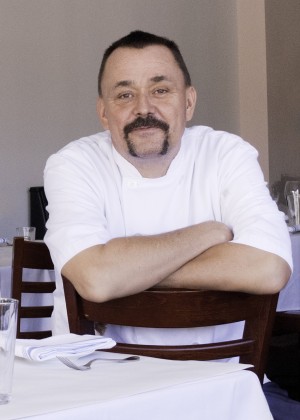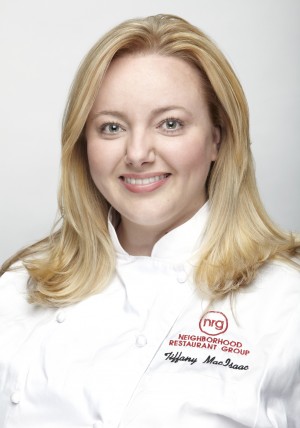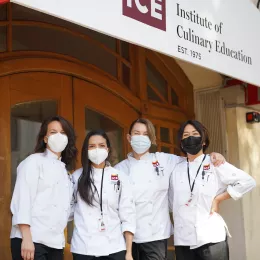When possible, I make the enjoyable effort to have a meal in the restaurants that ICE alumni have opened as executive chef and/or owner. I don't have to travel far to do this in metro New York. But in late August, I made some trips to visit alumni spots in Seattle, Philadelphia, and Washington, DC—all in the space of 12 days! That lead to the idea to have a long distance “roundtable” interview with the three ICE alumni chef/owners: Joncarl Lachman (‘02), Tiffany MacIsaac (’02), and Rachel Yang (’01).

In 2013, Chef Rachel Yang’s Seattle restaurant Joule ranked 9th on Bon Appétit’s “Best New Restaurants” in America list—an honor that was soon followed by a spot (two notches up) on Seattle magazine’s similar shortlist. Yang, along with chef/husband Seif Chirchi, was also acknowledged by Bon Appétit as a pioneer in Korean-American fusion cuisine, which they feature at Joule's sister restaurant Revel.
Executive Pastry Chef Tiffany MacIsaac’s recipes have been featured in Food & Wine and her restaurant Birch & Barley, which she runs with her husband, Executive Chef Kyle Bailey, has been recognized by top critics as one of Washington, DC’s must-eat destinations. A James Beard Award semi- finalist for Outstanding Pastry Chef in 2013, MacIsaac oversees the dessert program for all of Neighborhood Restaurant Group’s eateries which, in addition to Birch & Barley, include: Tallula, Eat- bar, Vermilion, Evening Star Cafe, Columbia Firehouse, Rustico, and Buzz Bakery.
Chef Joncarl Lachman is also no stranger to accolades. His Chicago restaurant Vincent was named one of Chicago magazine’s “Best New Restaurants” in 2011 and his HB Bistro was featured in the prestigious Michelin guidebook. This year Lachman opened his highly anticipated Noord, a "Dutch-American" eatery in Philadelphia, the city where he was raised. We asked these three impressive graduates to give some perspective and insight as to how they each have blazed a successful trail through what can be a very challenging career path. Here’s what they had to say:

How do the foods and flavors of your childhood fit into your current menu?
Joncarl: I grew up in Southwest Philadelphia surrounded by Italians. When I would go to my friends’ homes, their mothers would be making lasagna and meatballs, etc. I would return home to my own Dutch mother’s boiled cabbage and meat. Needless to say, at the moment, it was not a culinary inspiration. Little did I know I would end up in South Philly again surrounded by Italians, but this time it is me, and not my mother, making Dutch food!
Tiffany: I’m from Hawaii and I find that I tend to gravitate toward fresher, more acid desserts,—often incorporating passion fruit, pineapple, and other tropical fruits into my menu.
Rachel: Where I was from and my Korean heritage, definitely influenced the menu at Joule and Revel. That’s what makes our restaurants so unique.
At what point in your life did you know you wanted to become a chef?
Tiffany MacIsaac: When I turned 18 I moved to New York where my first job was as a hostess at Michael’s New York. I had never really experienced food as anything other than a way to fill your stomach. After a few months of working, they invited me in to dine in the restaurant. I fell in love with everything. But the moment I knew I wanted to get into the kitchen was when I tried the beef cheeks. It blew my mind and within a week, I was trailing in their kitchen.
Rachel Yang: It was only after college that I decided to cook. I had an idea of what it is like being a chef and a restaurateur but never thought that I would be one someday.

What is the process like to open a second, or third restaurant, versus the first?
Rachel: After a while, you can totally visualize the space and how the flow should work, even looking at the floor plan. You can construct a restaurant from every staff member’s point of view, whereas in the beginning, you can only see the restaurant from a cook’s point of view.
Joncarl: I have to admit, it almost becomes addicting. I was petrified when I made the first big step to open my own place. My second restaurant, Vincent, was not an easy experience, largely due to the fact that we brought-in other partners. With Noord, while it was certainly a leap of faith, I had more confidence.
Tiffany: I’d like to say that it gets easier with every opening. But after two restaurants, two bakeries, a doughnut shop and a brewery—I can say that each one presented its own challenges. Every time you do it, you are analyzing how to be better, faster, and smarter. You constantly push yourself to think of new ways to do things. Which certainly keeps you on your toes.
What are some of you “signature” dishes and were you surprised when they became so popular?
Rachel: One of our most popular dishes at Joule is our spicy rice cake. It’s really a great combination of the traditional rice cake dish from Korea and other very non-traditional items. It was my personal favorite when we put it on the menu, but I wasn’t sure how people would perceive it since it’s pretty darn spicy. We haven’t had any complaints that it is too spicy and, surprisingly, it’s been the most popular dish on the menu.
Tiffany: I started doing a cookie plate with kid classics and, four years later, it still hasn’t left the menu. Things like the Hostess cupcake, oatmeal cream pie, and Snickers bars—in a more grown-up version—are very appealing to customers. I knew they would be liked, but I didn’t think they would become such a big thing that they would never leave the menu.

Are there some ideas you thought would be a hit and turned out to be a flop?
Tiffany: I can never seem to get desserts with rice pudding to sell. People tell me all the time how much they love it, but I can’t seem to get them to buy a composed dessert featuring it.
How important—or not—are organic ingredients to your menu?
Rachel: It’s certainly important, but sometimes not the priority. We get organic and/or local ingredients whenever we can, but some ingredients are just really hard to come by or too expensive for us to serve at a decent price point.
Joncarl: I had the opportunity to work under Nora Pouillon, the “queen of organics,” at Restaurant Nora in Washington, DC. While it was a fantastic experience, it certainly affects a restaurant’s price point. We do our best to use locally farmed ingredients. If it is organic, it is a plus, but not a necessity.
Composing a new dish is sometimes simple and other times complex. Do you have a framework or set process when creating a new menu item?
Rachel: Sort of. I often have 2-3 key ingredients that I want to use and try to find an interesting way to connect them. Or I sometimes, I have a dish in mind and see a couple things I can change that would give it our signature stamp. At the end, I look for a “wow” factor in each dish, something that makes it stand out from others.
Tiffany: It’s not like I’ve got a sheet with boxes I check off as I’m developing a dessert. But, if all the components span several textures and temperature and you are able to make sure all the flavors taste distinctly like what they are supposed to, you are at a good starting point. I hate when a dessert doesn’t taste like its core components. Like a green apple sorbet that doesn’t have the right tartness or a ginger marshmallow with no bite. Keeping the balance of salt versus sweet will help the dessert from becoming cloying.
As an estimate, what percentage of your customers are regulars?
Rachel: There are quite a few regulars at both restaurants. Especially at Revel, we have a decent number of customers who come for lunch every week.
Joncarl: I would say 20 percent and growing. I love cultivating regular guests. It is honestly like having friends over to my home for dinner.
Tiffany: That’s interesting. At the restaurants, we strive for regulars that come in every couple of weeks. At the bakeries, we are trying to make people come in 4-5 times a week. I’d say 25 percent of Buzz bakery customer’s start or end their day here 3- 4 times a week, which is great.
What advice would you give to our culinary students on how to make the most of their first jobs out of school?
Tiffany: Find a chef whose food you are passionately in love with and give them everything you have—they’ll likely give a lot back to you. Don’t ask how much money you’ll make, or how long the day will be. That doesn’t matter at the beginning (or ever for that matter). The money will be low and the days will be long, but you aren’t done learning just because you finished school. Think about the hours as an investment in your future. And never leave your job in under 14 months. It just looks bad on a resume.
Rachel: Especially for the first restaurant job, you really need to put your head down and work. It sounds very boring and passive, but there is a reason why someone is asking you to clean a case of mushrooms or to cut quarts of shallots, brunoise, everyday. It takes time to master simple tasks. As you get used to doing this kind of work and can do it fast, your eyes will simply open up to what else is going on in the kitchen.
Joncarl: Keep your eyes and ears open. You know so much less than you think you do. Volunteer for as many events as possible. Be respectful. Get to know as many people in the industry as possible.
America seems to be experiencing a cocktail craze.Why do you think that is, and is mixology important at your restaurant?
Joncarl: I am incredibly annoyed by trends in general. I think the only other trend that annoyed me more was bacon, bacon, bacon....yawn!
As the restaurant scene continues to grow in your market, it must be more difficult to find—and retain—great staff. What methods do you use to deal with this challenge?
Rachel: The first thing that we want to make sure to do when we hire a cook is to see what the reason is that they want to work at our restaurants. We want to make sure that they have a very strong personal interest in working here. They need to love the food that we cook and be proud of where they are.
Joncarl: We have had the good fortune of keeping employees pretty long term. The type of environment I try to cultivate is very “familial.” When team members are emotionally invested in what we are doing, they tend to stay longer.
Tiffany: It is hard, but as a chef, you need to always be looking for good people, then give them opportunities to keep learning and growing.
If you could travel to a foreign country to learn about its cuisine, what country would that be?
Joncarl: One of my life goals was to see as much of the world as possible before I got serious about opening my own restaurants. I have been to 35 countries and spent some time living in the UK and Spain. I think my favorite place to experience the food was Singapore, and it would be great to re-visit and do more street stall eating. The next trip is back to Amsterdam, to catch up on the burgeoning modern Dutch cuisine that is happening in neighborhoods like the Jordaan and dePijp.
Tiffany: I’ve always wanted to go to Thailand. My husband and I thought we’d go there for our honeymoon, but we unexpectedly got job offers in DC and instead of honeymooning, we opened a restaurant—the opposite of a honeymoon.
Rachel: Maybe China. It would be great to learn about all regional Chinese cuisine and go beyond typical “Chinese flavor” that we are so used to in America.
What do you do to achieve a better or acceptable “work-life” balance?
Rachel: I have two little boys, three and a half years old and one and a half. They totally keep me going after a long day at work.
Joncarl: I think when you are a chef/owner the restaurant actually is your life—though it is good to take a mental health day every once in a while.
Tiffany: (Laughing) Is that a trick question? We still haven’t figured that one out yet. I guess I’d have to say that marrying the chef helps. Our work is our life, so I guess if we work all the time, then we balance it pretty well!




